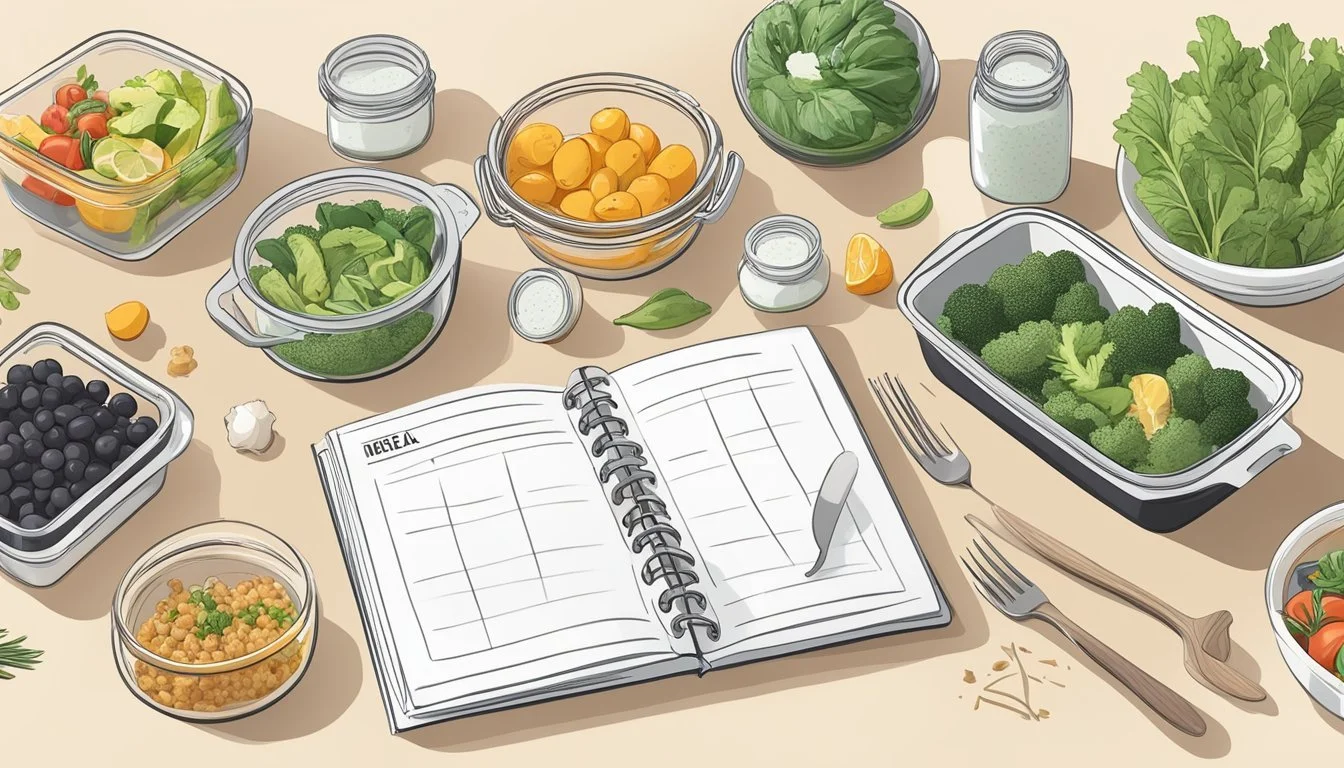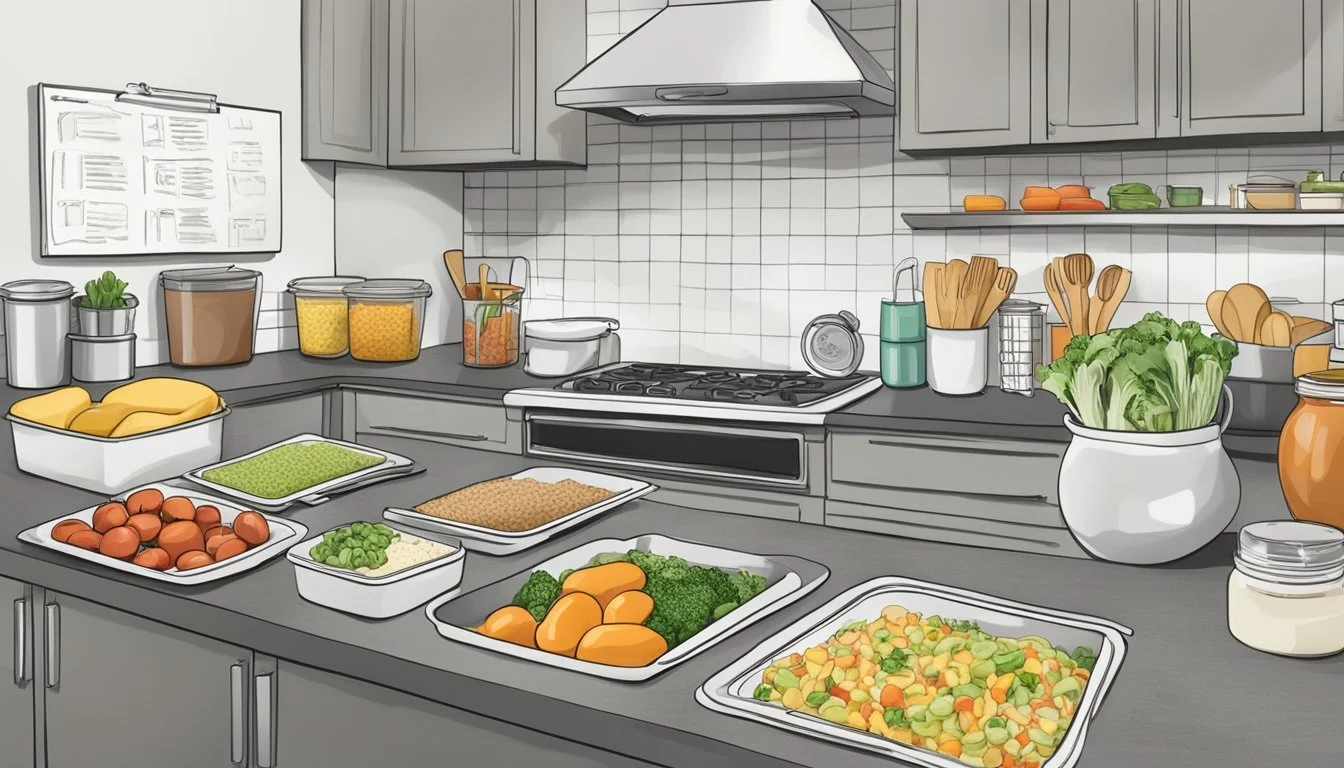10 Meal Prep Ideas for New Year's Resolutions
Kickstart Your Healthy Eating Goals
The turning of the calendar to a new year brings with it the tradition of setting resolutions. Among the most common goals that individuals set are those related to improving one's diet and establishing a healthier lifestyle. Meal prepping is a method that seamlessly aligns with these objectives, as it helps maintain healthy eating habits by encouraging planning and portion control. By preparing meals in advance, individuals can ensure they have nutritious food on hand, thus avoiding less healthy, impromptu dining options.
Incorporating meal prep into one's weekly routine can transform the way one approaches nutrition and daily meals. Rather than resorting to processed foods or takeout, meal prepping facilitates the selection of whole, nutrient-rich ingredients. This change is integral for those who aspire to nurture their well-being through diet. Additionally, meal prepping can simplify life, save time, and reduce stress related to last-minute meal decisions, making it a sustainable practice that supports healthy resolutions.
Success in meal prepping for the New Year, or any time, isn't solely a matter of willpower; it also involves thoughtful planning and smart food choices. Developing a repertoire of diverse and appealing recipes ensures that one stays motivated and enjoys a variety of flavors and nutrients. With meal prep, individuals can take concrete steps toward their New Year's resolutions for healthy eating and a balanced lifestyle, fostering a sense of accomplishment and well-being as the year progresses.
Why Meal Prep Aligns with Your New Year's Resolutions
As individuals gear up for a fresh start, integrating meal prep into their routine can strongly support their New Year's resolutions, particularly those centered around health and wellness.
Benefits of Meal Prepping
Organization & Time Efficiency: Meal prep can transform one’s dietary habits from reactive choices to a structured plan, ensuring that every meal aligns with health goals. By dedicating a few hours to prepare meals for the week, individuals save significant time and reduce daily stress about meal decisions.
Consistent Healthy Eating: Having meals ready-to-eat can deter the temptation to opt for convenient but unhealthy options, supporting resolutions around weight loss or better nutrition.
Cost-effectiveness: Bulk buying ingredients and minimizing food waste contribute to a more economical approach to eating, which can align with financial resolutions.
Portion Control: Pre-determined meal portions help avoid overeating, a common obstacle in weight management efforts.
Connecting Meal Prep to Lifestyle Changes
Habit Formation: Regular meal prepping can evolve into a beneficial habit, reinforcing consistency and discipline that can spill over into other areas of one’s life.
Energy & Mental Health: Balanced, nutrient-rich meals may enhance energy levels and mental clarity, fostering overall mental health.
Adaptability: Meal prep can be tailored to any dietary requirement or preference, making it a versatile tool for personal health aspirations.
Fundamentals of Meal Prep
Initiating a meal prep routine involves understanding the basics of meal planning and gathering the necessary essentials. Proper planning and preparation can lead to healthier eating habits and save time throughout the week.
Getting Started with Meal Planning
One begins the meal planning process by selecting recipes for the week's meals. A balanced approach typically includes proteins, a variety of vegetables, and whole grains. It's important to consider personal dietary needs and preferences, as well as the time available for cooking. They should create a grocery list based on these recipes, which helps avoid unnecessary purchases and facilitates efficient shopping trips.
Choose Recipes: Aim for recipes that have overlapping ingredients to minimize waste.
Make a List: Organize the grocery list by store sections such as produce, proteins, and dairy.
Essentials for Meal Prepping
Once they have a plan, one needs the right tools and containers for meal prepping. They should ensure they have quality kitchen equipment like sharp knives, cutting boards, and non-stick pans. Storage is key, so one must invest in a set of microwave-safe, airtight meal prep containers that can go from fridge to microwave to table.
Kitchen Tools:
Sharp knives
Durable cutting boards
Non-stick skillets and baking sheets
Meal Prep Containers:
Microwave-safe
Airtight seals
Various sizes for portion control
One should consider prepping components of meals that can be mixed and matched throughout the week, such as cooking proteins like chicken or tofu in bulk and chopping an array of vegetables. Cooking grains such as brown rice or quinoa in larger quantities can also save time, allowing for quick assembly of balanced meals.
Healthy Recipes for New Year
Embracing new meal prep ideas can significantly enhance one's New Year's resolutions by incorporating nutrient-dense foods like vegetables, lean proteins, whole grains, and fruits. These options are designed to cater to various dietary needs and preferences while focusing on health and simplicity.
Quick and Easy Meal Prep Ideas
For individuals seeking efficiency without sacrificing nutrition, quick and easy meal prep is essential. One can opt for chicken breast recipes that are rich in lean protein and can be prepared in advance. For instance, a grilled chicken seasoned with garlic and sage serves as an excellent base for various meals. Pairing with vegetables like roasted spinach and whole grains like quinoa can make for a balanced dish that's easy to assemble.
Recipe Idea: Garlic-Sage Chicken with Quinoa
2 boneless chicken breasts (marinated with garlic and sage)
1 cup cooked quinoa
A handful of spinach
Olive oil for cooking
Recipes for Dietary Restrictions
For those with dietary restrictions, meal prep can include lentils and legumes as substitutes for animal proteins. Utilizing nuts and seeds adds essential fatty acids and nutrients to the diet. One can prepare a lentil stew with an assortment of vegetables or a bean salad featuring a mix of black beans, chickpeas, and a citrus dressing for a refreshing and filling meal.
Sample Bean Salad:
1 can black beans, rinsed and drained
1 can chickpeas, rinsed and drained
1 red bell pepper, diced
Fresh parsley, chopped
Dressing: lemon juice, olive oil, salt, and pepper
Healthy Snack Options
Snacks are often overlooked in meal prep, yet they are crucial for maintaining energy levels throughout the day. Integrating snacks like Greek yogurt with a drizzle of honey and a sprinkle of nuts offers a sweet yet healthy option. Sliced fruits and homemade trail mix with whole nuts and dried fruits (What wine goes well with nuts and dried fruits?) provide quick bites that are both nutritious and satisfying.
Trail Mix Combination:
Almonds, walnuts, or pecans
Dried cranberries or raisins
A few dark chocolate chips (optional)
Pumpkin seeds or sunflower seeds
Smart Shopping for Meal Prep
When it comes to meal prep, the cornerstone of success lies in effective planning and smart shopping. One's ability to build a comprehensive shopping list and choose whole foods can lead to more nutritious meal choices and simplified preparation processes.
Building a Shopping List
To ensure a streamlined shopping experience, one should begin with a well-structured shopping list that aligns with their meal planning goals. This list should be an itemized representation of ingredients needed, which typically involves a range of vegetables, fruit, and other whole foods. A table format can be utilized to categorize items, manage quantities, and plan for multiple meals in advance.
Category Item Quantity Vegetables Green beans 1 lb Fruits Apples 6 Proteins Chicken Breast 4 pieces Whole Grains Quinoa 1 lb Dairy Greek Yogurt 32 oz
Choosing Whole Foods
Selecting whole foods can be beneficial for individuals aiming to maintain a healthy diet. They should prioritize fresh produce like vegetables and fresh fruits, as these are foundational components for a wide array of meal prep options. Vegetables and fruits not only provide essential nutrients but also contribute to the diversity of flavor for meals throughout the week. Shoppers can maximize their nutrient intake by choosing a colorful variety of these food groups, ensuring they get a broad spectrum of vitamins and minerals.
Vegetables: Opt for a mix of leafy greens for salads, cruciferous vegetables for roasting, and root vegetables for stews.
Fruits: Select seasonal fruits for snacking and incorporating into breakfast or dessert dishes.
Remember, the quality of the ingredients chosen will greatly influence the healthiness and taste of the prepared meals.
Cooking and Storage Tips
Proper technique can make meal prepping both effective and safe. This section addresses efficient methods to cook meals in batches as well as practices for storing them safely to maintain freshness and nutrition.
Efficient Cooking Techniques
To optimize time and energy while preparing meals, one should utilize methods such as batch cooking and leveraging tools like the microwave. For instance, quinoa can be cooked in large quantities and used as a base for multiple meals throughout the week. Additionally, incorporating healthy fats like avocado oil can enhance flavors and provide nutritional benefits.
Microwave: A powerful tool for reheating meals or steaming vegetables quickly.
Batch Cooking: Cook large quantities of staple ingredients, such as grains and proteins, to use across various meals.
Healthy Fats: Use oils rich in omega-3s, such as flaxseed or olive oil, when preparing meals to contribute to a balanced diet.
Safe Food Storage Practices
Storing food safely is vital for preserving its quality and preventing foodborne illnesses. One can use reusable containers to store components such as cooked tofu or fresh berries efficiently in the refrigerator. Segregating cooked items from raw helps to minimize cross-contamination.
Refrigeration: Cool down cooked foods before refrigerating, and store items like tofu and quinoa at temperatures below 40°F.
Reusable Containers: Opt for glass or BPA-free plastic containers to store meals; they are eco-friendly and can be used multiple times.
Proper labeling with dates ensures consuming the food while it's still fresh, and designating areas in the fridge for particular types of food aids in organized storage and easy access.
Special Sections for Specific Needs
Adapting meal prep to fit individual lifestyles and dietary preferences is imperative. Below are specific ideas that cater to active individuals, those focusing on mental well-being, and strategies for picky eaters.
Meal Prep for Active Lifestyles
For those with an active lifestyle, meal prep should fuel the body with a balance of protein, carbohydrates, and fats for sustained energy. They might consider prepping:
Chicken and Quinoa Salad: A high-protein meal that's easily portable for post-gym sessions.
Overnight Oats: A mix of complex carbs and protein, ideal for a pre-workout breakfast.
Nutrition for Mental Well-Being
Nutrition can significantly impact one's mental well-being. Foods rich in omega-3 fatty acids, antioxidants, and vitamins are beneficial. They might incorporate:
Salmon with Steamed Broccoli: Omega-3 helps support brain function.
Berry and Spinach Smoothies: Berries are high in antioxidants, and spinach is rich in folate.
Accommodating Picky Eaters
Picky eaters need enticing and nutritious meals. Creativity is key to ensuring they get a balanced diet. They could try:
Build-Your-Own Tacos: Offers control over ingredients, encouraging trying new foods.
Hidden Veggie Pasta Sauce: Integrating vegetables into familiar foods like pasta.
Overcoming Challenges in Meal Prep
When pursuing the goal of preparing homemade meals for a healthier lifestyle, individuals often face challenges like time management and maintaining motivation. Addressing these issues is essential to making meal prep a sustainable and rewarding part of one's routine.
Dealing with Time Constraints
One often encounters the challenge of finding enough time to prepare meals. A specific and achievable strategy is to select recipes that require minimal active cooking time or can be batch-cooked.
Batch Cooking: Prepare large portions of meals at once to save time throughout the week.
Ingredient Prep: Wash, chop, and store ingredients in advance, so they are ready to cook.
Efficient Recipes: Opt for recipes that can be made in a slow cooker or on a sheet pan to minimize hands-on time.
Staying Motivated
Motivation can wane, but by setting specific objectives and celebrating small improvements, one can remain committed.
Goal Setting: Define clear goals for the number of meals to prepare each week.
Variety: Incorporate a diverse range of recipes to avoid monotony.
Mindful Eating: Reflect on the benefits of eating homemade meals, such as healthier ingredients and portion control, to fuel motivation.
Advanced Meal Prep Strategies
Advanced meal prep goes beyond simple recipes and ingredients, focusing on maximizing nutrition and catering to specific health needs. It involves integrating nutrient-dense superfoods and adapting meals for various health conditions.
Incorporating Superfood
Superfoods offer concentrated nutrients that can revolutionize meal prep for the health-conscious. When preparing salads, for example, one can leverage leafy greens like spinach and kale—packed with vitamins, minerals, and antioxidants. Including a variety of veggies such as beets or sweet potatoes can enhance both flavor and nutritional value. Integrating herbs like parsley or cilantro not only adds a punch of taste but also confers detoxifying properties. For proteins, fish, especially fatty types like salmon, provides omega-3 fatty acids, crucial for heart and brain health.
Salads: Aim for a rainbow of vegetables topped with seeds like chia or flax.
Proteins: Opt for grilling or baking fish to preserve omega-3s.
Flavor: Use fresh herbs rather than heavy dressings to cut calories and boost nutrient uptake.
Tailoring Meals to Health Conditions
Customizing meals to address specific health conditions can lead to better health outcomes and adherence to dietary plans. For those managing heart disease, reducing sodium and incorporating heart-healthy omega-3 fats from fish can support cardiovascular health. Complex carbohydrates like quinoa or sweet potatoes are better choices for individuals with type 2 diabetes, as they have a lower glycemic index and help maintain steady blood sugar levels.
Heart Disease: Focus on low-sodium veggies and lean proteins.
Type 2 Diabetes: Balance your plate with complex carbs and fiber-rich vegetables to slow glucose absorption.
By adopting these advanced strategies, individuals can make informed choices that align with their health objectives, leading to a more successful and sustainable meal prep routine.
Cultural and Taste Exploration
When embracing new year's resolutions, one can profoundly enrich their culinary experience by experimenting with diverse international flavors and plant-based alternatives. This exploration not only revitalizes the palate but also expands one's nutritional horizon.
Trying International Flavors
Individuals can transport their taste buds around the globe right from the kitchen by incorporating international dishes into their meal prep. Tex-Mex, for example, provides a comforting fusion of American and Mexican cuisines. A Tex-Mex meal prep might include a Chicken Fajita Bowl with seared peppers and onions, seasoned with cumin and chili powder. Another global flavor to explore is Chinese, where Chow Mein stands out with its tantalizing combination of noodles, vegetables, and a savory soy-based sauce.
International Suggestions:
Tex-Mex: Chicken Fajita Bowl, Beef and Bean Burritos
Chinese: Vegetable Chow Mein, Kung Pao Tofu
Exploring Plant-Based Alternatives
Embracing plant-based alternatives can reinvent traditional meals and is a stepping stone to healthier eating habits. Tofu, a versatile soy-based protein, absorbs the flavors of its seasonings, making it an ideal substitute in many recipes. The incorporation of tofu in a stir-fry or curry allows for a protein-rich meal without the need for meat. Lentils are another nutritious alternative, packed with protein and fiber, and can be used to craft a hearty Lentil Bolognese. To enhance the nutritional value further, seeds like chia or flax can be sprinkled into dishes, and peanut butter can be used as a base for dressings and sauces.
Plant-Based Picks:
Proteins: Grilled Tofu Steaks, Lentil Shepherd's Pie
Condiments: Homemade Peanut Butter Dressing, Mixed Seed Topping
Health and Nutrition Insights
Effective meal prep revolves around understanding the nutritional value of food and how it impacts an individual's health. The selection of ingredients plays a crucial role in meeting dietary needs and supporting mental health.
Understanding Macronutrients
Protein is a fundamental macronutrient needed for muscle repair and growth. Sources of high-quality protein include lean meats, legumes like lentils and chickpeas, and tofu for those following a plant-based diet. Healthy fats underscore the need for a balanced diet, with avocados and nuts being excellent choices.
When planning meals, one should aim for a good balance of macronutrients:
Proteins: 10-35% of daily calories
Fats: 20-35% of daily calories
Carbohydrates: 45-65% of daily calories
The Role of Antioxidants
Antioxidants are vital compounds that help protect the body from oxidative stress. Fruits and berries, such as blueberries and strawberries, are rich in antioxidants and can be easily incorporated into meals as snacks or in smoothies. Dark leafy greens like spinach not only offer antioxidants but are also nutrient-dense, supporting overall health.
A regular intake of antioxidants can lead to:
Improved mental health
Lower risk of chronic diseases
In meal prep, aiming for a colorful plate ensures a variety of antioxidants and other nutrients are included.
Integration with Lifestyle Goals
Successfully integrating meal prep with lifestyle goals requires synchronizing nutritional habits with exercise and self-care routines. The focus is on creating a balance that supports not just weight loss, but also overall health and emotional well-being.
Balancing Diet and Physical Activity
For those aiming to lead a healthier lifestyle or achieve weight loss, synchronizing diet with physical activity is essential. Meal prep can cater to specific dietary needs that fuel the body for exercise and aid recovery. For instance, a high-protein meal may support muscle repair after strength training, while complex carbohydrates can provide sustained energy for endurance activities.
Pre-Workout Meals: Containing a good mix of proteins and complex carbohydrates to fuel physical activity.
Post-Workout Meals: Rich in protein to aid in muscle recovery and healthy fats to reduce inflammation.
Properly planned meals can help regulate blood pressure and improve cardiovascular health, complementing an active lifestyle where regular exercise is a staple.
Self-Care Through Nutrition
Meal prepping can also be a form of self-care, ensuring that individuals take time out of their schedules to nourish their bodies with wholesome food. Taking control of one's diet often reduces anxiety associated with unplanned eating and last-minute meal choices.
Mindful Eating Practices: Incorporating ingredients that promote relaxation, such as magnesium-rich greens, to complement meditation and stress-reduction techniques.
Nutrient-Dense Meals: Planning meals that are rich in vitamins, minerals, and antioxidants supports mental health and combats stress.
By being intentional about meal prep, individuals can make more time for activities like meditation, as they spend less time each day worrying about what to eat. Proper nutrition plays a direct role in managing stress and is an often-overlooked aspect of self-care.
FAQs and Troubleshooting
In this section, we provide crucial advice for successful meal prep, offering answers to common questions and clarifying misconceptions. Whether you're just beginning or need to refine your meal planning strategy, these insights will guide you toward healthier eating habits.
Common Meal Prep Questions
Q: How much food should I prep for a week?
A: This depends on individual dietary needs and schedules. As a rule of thumb, one should plan for all main meals and snacks, factoring in portion sizes according to personal health goals.
Q: Can meal prep help with weight management?
A: Yes, pre-planning meals enables portion control, helps to resist impulsive eating, and ensures a balance of nutrients, all of which are critical in managing weight.
Q: How do I store my meal preps?
A: Use airtight containers and refrigerate or freeze meals as required. Labeling with prep dates ensures food safety and quality.
Q: Is it okay to repeat meals throughout the week?
A: Absolutely. Repeating meals can simplify shopping and cooking, provided that the diet remains varied overall for nutritional balance.
Addressing Meal Prep Myths
Myth: Meal prepping is too time-consuming.
Fact: While it involves an upfront time investment, meal prepping ultimately saves time during the week, streamlining cooking processes and decision-making.
Myth: Healthy meal prep is expensive.
Fact: Meal prep can be cost-effective as it reduces food waste and reliance on often expensive, less healthful takeout options.
Myth: Freshly prepared food is healthier than prepped meals.
Fact: If handled and stored properly, meal prepped food retains its nutritional value and can contribute to a healthy diet just as much as fresh meals.
Myth: Meal prepping limits food variety.
Fact: Meal prepping actually encourages diversity by allowing individuals to plan a range of balanced meals ahead of time.
For additional inquiries or specific meal planning advice, readers can consider reaching out through email to a nutrition expert or meal planning service for personalized guidance.








